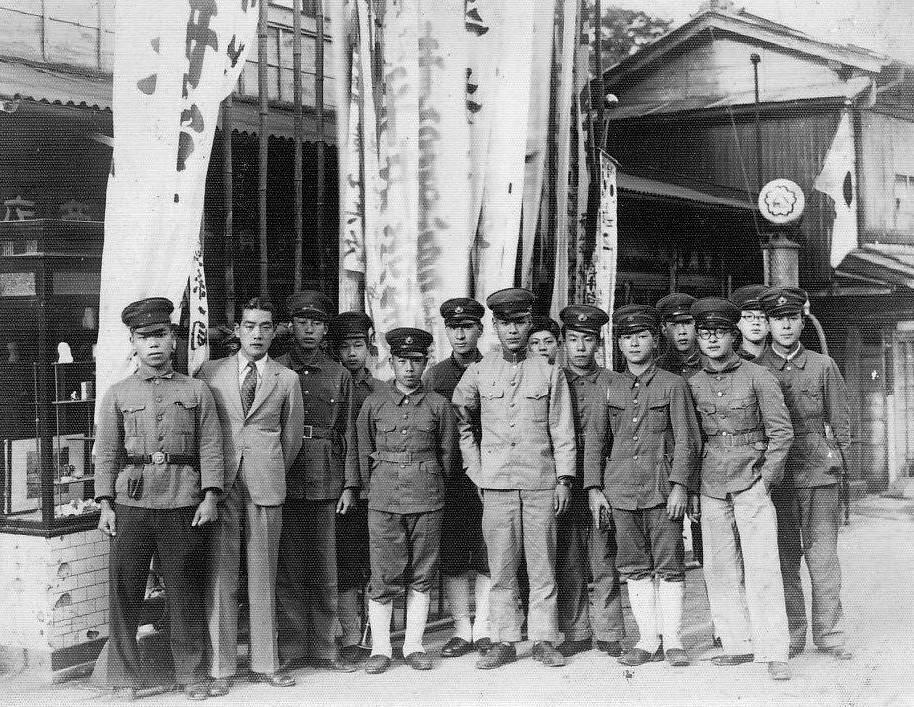
World War II: Japanese Military Factions--Strike North Faction

Figure 1.--The Jpanese military throughout the early-20th century steadily increased their influence in state affairs. And the idea that Japan should acquire a large empire like the European powers became an article of faith, especially among the ardently nationalistic officer corps. This only increased after World War I as Japan increasingly sought to expand its control over China. This group of young Japanese about 1930 look to be involved in the military, although we are unsure about the connecting thread as they are dressed differently, mostly in uniforms. Perhaps they are cadets. One reader suggests that war banners are in the background. Unfortunatly we have no idea what they say.
|
|
The Japanese military was divided by factions. There was little disagreement over the idea that Japan should use its growing military power to expand the Empire. The primary divisiom was how best to use military power. The Strike North Faction became the dominant orientation of the Japanese Army, strongly influencing the Japanese High Command. The Strike North Faction grew out of Kōdōha (the Imoerial Way). This was a political/social outlook enunciated by Sadao Araki and his protégé Jinzaburō Masaki. Araki was a respected political philosopher within the Army. His central thesis was linking the ancient samurai bushido code with modern nationalism. Kōdōha had many ideas similar to European Fascism which also embraced militarism and rejected liberal democracy. Araki fuseddevotion to the Emperor, the people, the land, and morality into a unified nationalist spirit. Despite the fact that it was Japan's industrial development that had enabled Japan to emerge as an important power, Kōdōha saw a need to return to a nostalgic notion of an idealized pre-industrialized Japan, uncorupted by the West. Araki saw the need to purge the strate of corrupt bureaucrats, opportunistic politicians, and greedy zaibatsu capitalists. The corrupt, greedy, and oportunistic were often simply those who had question the ideas held by impressionable young officers. He saw aurified state as being led by the the Emperor n a "Showa Restoration" backed by the military. tion of the military in terms of For Araki and his followers, central to military preparation was ideologicalm or spiritual training, something akin to French élan. important. Prime Minister Inukai appointed Araki Minister of War (1931). Mazaki was appointed Vice Chief of the Imperial Japanese Army General Staff. From those positions, both proceeded to purge followers of their chief rival General Kazushige Ugaki from key posts in both the Ministry and the General Staff. Ugaki in contrast to philosophy saw the need to modernizae weaponry as more important. Kōdōha emerged as a major component of the Strike North Faction, in part because of its strident anti-Communist orintation. This orientation was especially strong in the Kwantung Army stationed in Manchukuo. There strategic concept was simple--sever the Soviet Trans-Siberian lifeline. The Railway was vulnerable because for over a thousand miles in ran close to the Manchukuo border. And if Japan could seize Mongolia there were even more places to cut the Railline. The Strike North Faction srgued that if Japan could cut the Transiberian, the Soviets would have no way to supply military forces in the Far East. The Imperial Japanese Navy could prevent supply by sea. The potential gains were emense: Mongolia, the Soviet maritime provinces, and large parts of Siberia. These buffer territories woild shield the Japanese Empire in the north and provide the Japanese the enormous natural resources of Siberia. Striking north would also cut the Chinese Nationslists off from Soviet assistance. And advocates within the Army believed that this was the most achievable as it required war only with the Soviet Union.
CIH

Navigate the CIH World War II Section:
[Return to Main World War II Japanese Road to War page]
[Return to Main Japanese World War II page]
[Return to Main World War II Pacific campaign page]
[Biographies]
[Campaigns]
[Children]
[Countries]
[Deciding factors]
[Diplomacy]
[Geo-political crisis]
[Economics]
[Home front]
[Intelligence]
[POWs]
[Resistance]
[Race]
[Refugees]
[Technology]
[Totalitarian powers]
[Bibliographies]
[Contributions]
[FAQs]
[Images]
[Links]
[Registration]
[Tools]
[Return to Main World War II page]
[Return to Main war essay page]
[Return to CIH Home page]
Created: 10:57 PM 11/18/2014
Last updated: 10:57 PM 11/18/2014



